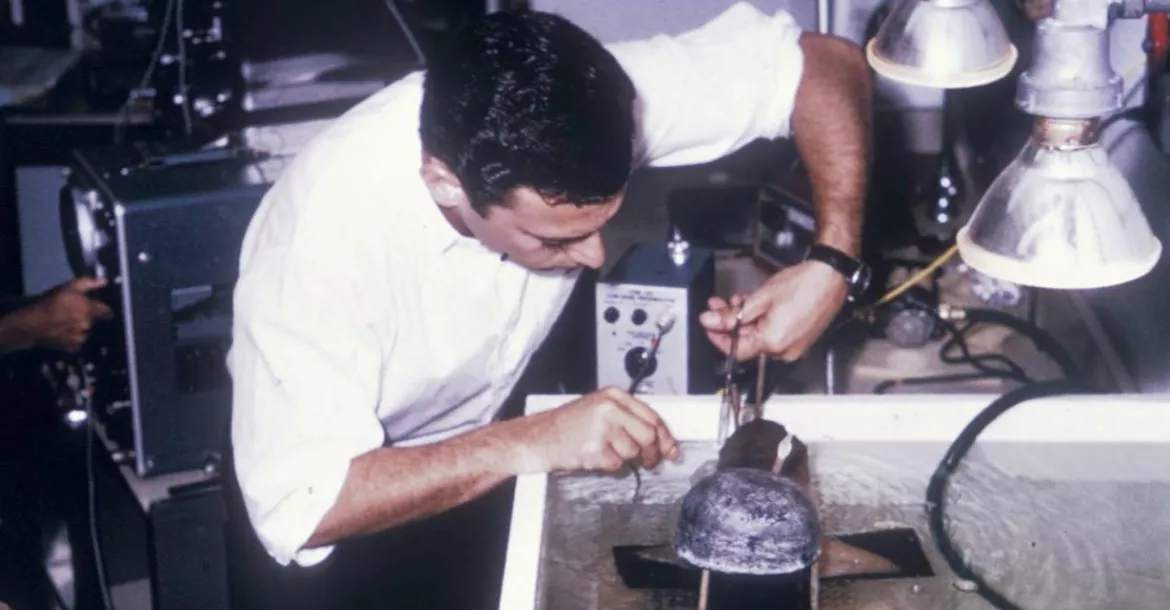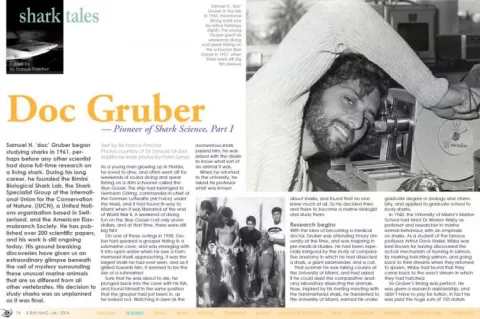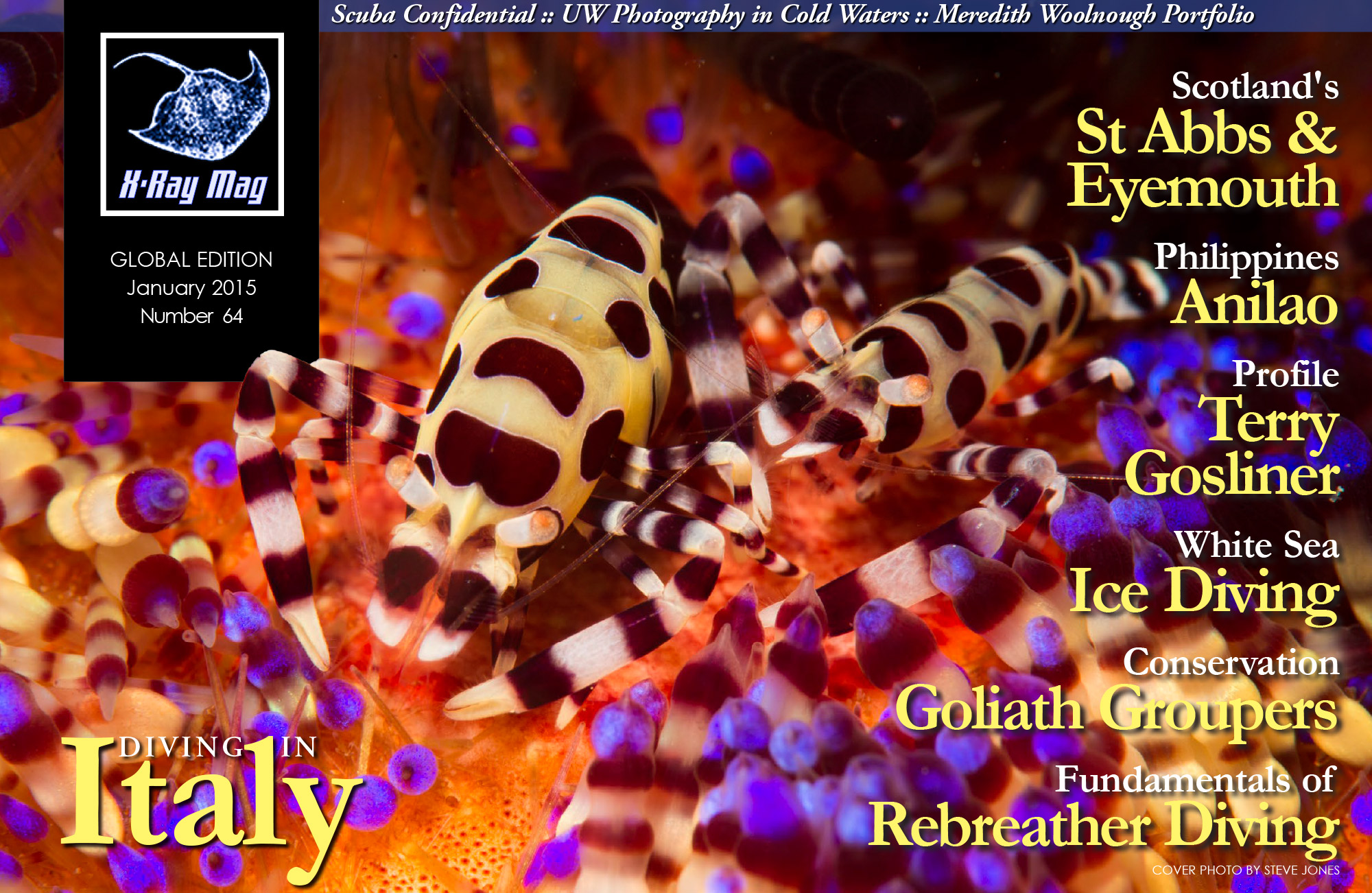Samuel H. ‘doc’ Gruber began studying sharks in 1961, perhaps before any other scientist had done full-time research on a living shark. During his long career, he founded the Bimini Biological Shark Lab, the Shark Specialist Group of the International Union for the Conservation of Nature, (IUCN), a United Nations organization based in Switzerland, and the American Elasmobranch Society.
Contributed by
Dr. Gruber has published over 200 scientific papers, and his work is still ongoing today. His ground breaking discoveries have given us an extraordinary glimpse beneath the veil of mystery surrounding these unusual marine animals that are so different from all other vertebrates. His decision to study sharks was as unplanned as it was final.
As a young man growing up in Florida, he loved to dive, and often went off for weekends of scuba diving and spear fishing on a 30m schooner called the Blue Goose. The ship had belonged to Hermann Göring, commander-in-chief of the German Luftwaffe (Air Force) under the Nazis, and it had found its way to Miami when it was liberated at the end of World War II. A weekend of diving fun on the Blue Goose cost only seven dollars, and at that time, there were still big fish!
On one of these outings in 1958, Gruber had speared a grouper hiding in a submarine cave, and was emerging with it into open water when he saw a hammerhead shark approaching. It was the largest shark he had ever seen, and as it glided towards him, it seemed to be the size of a submarine!
Sure that he was about to die, he plunged back into the cave with his fish, and found himself in the same position that the grouper had just been in, as he looked out. Watching in awe as the momentous shark passed him, he was seized with the desire to know what sort of an animal it was. When he returned to the university, he asked his professor what was known about sharks, and found that no one knew much at all. So he decided then and there to become a marine biologist and study them.
Research begins
With the idea of becoming a medical doctor, Gruber was attending Emory University at the time, and was majoring in pre-medical studies. He had been especially intrigued by the study of comparative anatomy in which he had dissected a shark, a giant salamander, and a cat. That summer he was taking courses at the University of Miami, and had asked if he could assist the comparative anatomy laboratory dissecting the animals. Now, inspired by his riveting meeting with the hammerhead shark, he transferred to the University of Miami, earned his undergraduate degree in zoology and chemistry, and applied to graduate school to study sharks.
In 1960, the University of Miami’s Marine School had hired Dr Warren Wisby as professor and researcher in marine animal behaviour, with an emphasis on sharks. As a student of the famous professor Arthur Davis Hasler, Wisby was best known for having discovered the actual mechanism of homing in salmon. By marking hatchling salmon, and going back to their streams when they returned to spawn, Wisby had found that they came back to the exact stream in which they had hatched. So Gruber’s timing was perfect. He was given a research assistantship, and didn’t have to pay for tuition. In fact he was paid the huge sum of 103 dollars a month as a graduate student there!
Wisby told him that the Navy had given them a grant to study shark senses. When aircraft went down at sea, it happened at times that sharks attacked the flyers in the water. In those days flyers wore two types of suits—high visibility suits called International Orange, and the standard khaki flying suits. According to a Navy report, the flyers wearing International Orange suits were attacked to a man, while the ones wearing khaki suits were left alone. As a result, the Navy had started calling those orange suits yum yum yellow. Wisby directed Gruber to look at the literature and report back on the possibility that sharks have colour vision. So he examined all the old reports. They were mostly in German, and they concluded that sharks could not see colours because they lacked the cone-shaped photoreceptors in the eye’s retina that permit colour vision in humans and other animals.
Duplexity Theory
The Duplexity Theory of vision was introduced in the 1860s by a German scientist named Max Schultze, and states that rods and cones in the retinas of an animal that possesses both, have two functions. Rods are used in night vision when there is little light, while the cones take over during the day, providing the ability to see colours, fine details, and to discern rapidly flashing lights. Some animals, such as squirrels and iguanas, that are active in daytime, have no rods in their eyes, and nocturnal animals or those adapted to the darkness of caves or the deep sea, have no cones. Therefore, the lack of cones found by early researchers in the retinas of sharks, suggested that they were unable to distinguish colours.
But Wisby questioned the old conclusions. He asked Gruber to go out and actually collect sharks’ eyes, and see what he could find. So Gruber went to shark tournaments and collected the eyes of every species of large shark caught off the of the eastern seaboard of the United States. He put a catheter into their hearts while they were still beating—the animals were brain-dead—and perfused gluteraldehyde, a preservative chemical, through their arteries, to fix their eyes for future study under the electron microscope. On one occasion, he was notified that a young great white shark was caught and was being held for him. This was the chance of a lifetime for the young graduate student, as white sharks were very rare. He ran out in a boat to where the fisherman was waiting with a barely living 54 lb specimen, successfully perfused the shark, and collected the eyes.
Can sharks see colour?
Year after year, Gruber worked in a histology lab comparing the retinas photographs of the many species of sharks to see whether they had both rods and cones. And, amazingly, every species he studied had them. Some species seemed to have better retinas than others, but they all had rods and cones. The great white shark had five rods to one cone, which was an especially high ratio.
It seemed that the earlier scientists had studied the cold-water, bottom-loving sharks of the northern seas off Europe, and those species had very few cone cells because they were adapted to dark conditions. Those inaccurate early findings had resulted in many false ideas about sharks taking root. The idea that they had an excellent sense of smell had spread because they came quickly to a scent, and so the concept of a shark as a swimming nose, with poor eyesight, was born a century ago.
The forebrain of a shark, called the telencephalon, is considered one of the most important parts of the brain, like our cerebral hemispheres. And in the shark, the telencephalon was thought to be the centre that analysed scents, because that was how it looked to the early researchers. They did not know how the forebrain worked, and they had never looked at how sharks really behaved, or tried to do neural examinations, yet their primitive ideas about sharks had persisted.
Wisby was pleased with Gruber’s discovery, but pointed out that just because the sharks had cone cells, didn’t mean that they could see colours. “What do the rods and cones mean for sharks?” Wisby asked, and directed Gruber to experiment to learn whether sharks see colours, and investigate their other visual capabilities. As the eyes of a human or animal adapt to darkness, rods take over the function of vision, providing high sensitivity to light, but no colour. The switching over between the cones and rods is something that can be measured, and it was this line of research that Gruber began to pursue in 1962 for his master, and later his doctorate degrees.
He used the lemon shark as a model, and chose three methods to test the Duplexity Theory of vision in sharks. To assess the rod and cone activity in the retina, he put contact lens electrodes on anaesthetized lemon sharks, and recorded the electrical responses of the retina when illuminated. He used electrophysiology to record electroretinograms, which are similar to the electrocardiogram of doctors, in order to examine the electrical activity of the associated neurons. His second method involved a behavioural study, following the Pavlovian method of testing called classical or respondent conditioning, and the third was the Skinnerian method, which is called operant conditioning.
Gruber’s results were unambiguous. The three methods gave the same results—there was no doubt that sharks could see colour. The rods functioned as expected in the dark, and the cones were most active in the light-adapted state. He found that as sharks adjusted to darkness, the sensitivity of their eyes became greater and greater, and reached the maximum dark-adaptation after about an hour, achieving a million-fold increase in sensitivity!
They adapted better than humans because unlike us, they possess the tapetum lucidum. This is the mirror-like membrane at the back of the eye which produces eye-shine in some animals. Light entering the eye passes through the retina, and is reflected, as if by a mirror, back from this membrane, potentially doubling the eye’s sensitivity.
Learning rate
Another interesting finding that emerged from Gruber’s research during his doctoral studies was the speed at which sharks learn. He was working on Pavlovian training conditioning, doing an experiment in which a shark would see a flash of light, and then receive a mild electric ...
(...)






























